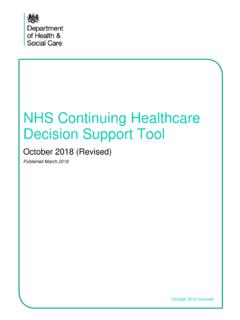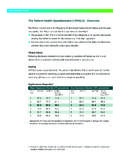Transcription of The Geriatric Assessment - American Academy of Family ...
1 48 American Family Physician Volume 83, Number 1 January 1, 2011 The Geriatric AssessmentBASSEM ELSAWY, MD, and KIM E. HIGGINS, DO, Methodist Charlton Medical Center, Dallas, Texas Approximately one-half of the ambu- latory primary care for adults older than 65 years is provided by fam- ily physicians,1 and approximately 22 percent of visits to Family physicians are from older ,3 It is estimated that older adults will comprise at least 30 percent of patients in typical Family medicine outpa-tient practices, 60 percent in hospital prac-tices, and 95 percent in nursing home and home care complete Assessment is usually initiated when the physician detects a potential prob-lem such as confusion, falls, immobility, or incontinence.
2 However, older persons often do not present in a typical manner, and atypi-cal responses to illness are common. A patient presenting with confusion may not have a neurologic problem, but rather an infec-tion. Social and psychological factors may also mask classic disease presentations. For example, although 30 percent of adults older than 85 years have dementia, many physicians miss the ,6 Thus, a more structured approach to Assessment can be Geriatric Assessment is a multidimen-sional, multidisciplinary Assessment designed to evaluate an older person s functional ability, physical health, cognition and mental health, and socioenvironmental circumstances.
3 It includes an extensive review of prescription and over-the-counter drugs, vitamins, and herbal products, as well as a review of immu-nization status. This Assessment aids in the diagnosis of medical conditions; development of treatment and follow-up plans; coordina-tion of management of care; and evaluation of long-term care needs and optimal Geriatric Assessment differs from a typical medical evaluation by including nonmedical domains; by emphasizing func-tional capacity and quality of life; and, often, by incorporating a multidisciplinary team including a physician, nutritionist, social worker, and physical and occupational ther-apists.
4 This type of Assessment often yields a more complete and relevant list of medical problems, functional problems, and psycho-social of the demands of a busy clinical practice, most Geriatric assessments tend to be less comprehensive and more problem-directed. For older patients with many con-cerns, the use of a rolling Assessment over several visits should be considered. The roll-ing Assessment targets at least one domain for screening during each office visit. Patient-driven Assessment instruments are also popular. Having patients complete question-naires and perform specific tasks not only saves time, but also provides useful insight into their motivation and cognitive Geriatric Assessment is a multidimensional, multidisciplinary Assessment designed to evaluate an older person s functional ability, physical health, cognition and mental health, and socioenvironmental circumstances.
5 It is usually initiated when the physician identifies a potential problem. Specific elements of physical health that are evaluated include nutrition, vision, hearing, fecal and urinary continence, and balance. The Geriatric Assessment aids in the diagnosis of medical conditions; development of treatment and follow-up plans; coordination of management of care; and evaluation of long-term care needs and optimal placement. The Geriatric Assessment differs from a stan-dard medical evaluation by including nonmedical domains; by emphasizing functional capacity and quality of life; and, often, by incorporating a multidisciplinary team.
6 It usually yields a more complete and relevant list of medical problems, functional problems, and psychosocial issues. Well-validated tools and survey instruments for evaluating activities of daily living, hearing, fecal and urinary continence, balance, and cognition are an important part of the Geriatric Assessment . Because of the demands of a busy clinical practice, most Geriatric assessments tend to be less comprehensive and more problem-directed. When multiple concerns are presented, the use of a rolling assess-ment over several visits should be considered. (Am Fam Physician.)
7 2011;83(1):48-56. Copyright 2011 American Academy of Family Physicians.)DOWNLOADED FROM THE American Family PHYSICIAN WEB SITE AT COPYRIGHT 2010 American Academy OF Family PHYSICIANS. FOR THE PRIVATE, NONCOMMERCIAL USE OF ONE INDIVIDUAL USER OF THE WEB SITE. ALL OTHER RIGHTS RESERVED. CONTACT FOR COPYRIGHT Geriatric AssessmentJanuary 1, 2011 Volume 83, Number 1 American Family Physician 49 Functional AbilityFunctional status refers to a person s ability to perform tasks that are required for living. The Geriatric Assessment begins with a review of the two key divisions of functional ability: activities of daily living (ADL) and instrumental activities of daily living (IADL).
8 ADL are self-care activities that a person performs daily ( , eating, dressing, bath-ing, transferring between the bed and a chair, using the toilet, controlling bladder and bowel functions). IADL are activities that are needed to live independently ( , doing housework, preparing meals, taking medications properly, managing finances, using a telephone). Physicians can acquire useful functional information by simply observ-ing older patients as they complete simple tasks, such as unbuttoning and buttoning a shirt, picking up a pen and writing a sentence, taking off and putting on shoes, and climbing up and down from an examination table.
9 Two instruments for assessing ADL and IADL include the Katz ADL scale (Table 1)8 and the Lawton IADL scale (Table 2).9 Deficits in ADL and IADL can signal the need for more in-depth evaluation of the patient s socioenvironmental circumstances and the need for additional : KEY RECOMMENDATIONS FOR PRACTICEC linical recommendationEvidence ratingReferences The Preventive Services Task Force found insufficient evidence to recommend for or against screening with ophthalmoscopy in asymptomatic older 15 Patients with chronic otitis media or sudden hearing loss, or who fail any hearing screening tests should be referred to an , 23 Hearing aids are the treatment of choice for older patients with hearing impairment.
10 Because they minimize hearing loss and improve daily Preventive Services Task Force has advised routinely screening women 65 years and older for osteoporosis with dual-energy x-ray absorptiometry of the femoral Centers for Medicare and Medicaid Services encourages the use of the Beers criteria as part of an older patient s medication Assessment to reduce adverse , 40 A = consistent, good-quality patient-oriented evidence; B = inconsistent or limited-quality patient-oriented evidence; C = consensus, disease-oriented evidence, usual practice, expert opinion, or case series.















